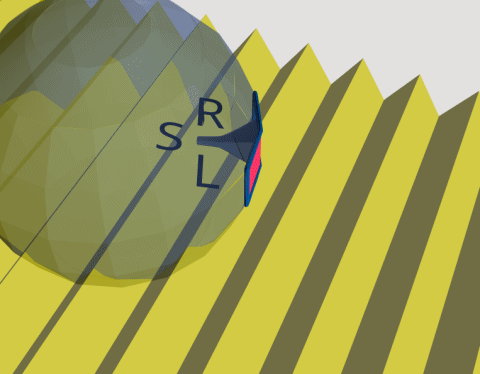Saturday, September 21, 2019
More "energy efficiency" in Nature
Via Eurekalert, new research on one of Nature's extremely "efficient" pieces of design.
 When the signal is coming from straight ahead, the middle of the eardrum moves, but there's no differential back-and-forth. The S neuron is sensing presence of signal.
= = = = =
In the second animation the insect has turned toward the left.
When the signal is coming from straight ahead, the middle of the eardrum moves, but there's no differential back-and-forth. The S neuron is sensing presence of signal.
= = = = =
In the second animation the insect has turned toward the left.
 The high-pressure phase of the sound wave strikes the right window before it strikes the left window. The malleus rocks back and forth, giving the insect an OFF-BEAM warning, just like Loran.
So the fly walks forward, using the R and L neurons for negative feedback. When the off-beam indicator is pulsing, she turns one way or the other until it stops.
Energy efficiency? A tremendously clever and unique design, used only in this one insect, and only in the adult version of the insect which lives long enough to fuck and lay eggs and die.
The high-pressure phase of the sound wave strikes the right window before it strikes the left window. The malleus rocks back and forth, giving the insect an OFF-BEAM warning, just like Loran.
So the fly walks forward, using the R and L neurons for negative feedback. When the off-beam indicator is pulsing, she turns one way or the other until it stops.
Energy efficiency? A tremendously clever and unique design, used only in this one insect, and only in the adult version of the insect which lives long enough to fuck and lay eggs and die.
The fly Ormia ochracea has evolved directionally sensitive ears to eavesdrop on the communication signals of field crickets. Crickets that are parasitized by these flies face almost certain death. How these flies recognize cricket songs and whether crickets can change their love songs to avoid parasitism is unknown. The Lee Lab of Neural Systems and Behavior at St. Olaf College will apply this new approach to unravel how different geographic populations of O. ochracea have evolved to recognize and prefer species-specific cricket songs that mainly differ in the temporal patterning of sound pulses. Temporal pattern recognition is a common sensory processing task shared by many animals that communicate with acoustic signals, including human speech. Studying temporal pattern recognition in O. ochracea may provide insights into general auditory system function involved in signal recognition. Lee believes that his research into O. ochracea hearing can be harnessed to help improve human hearing by providing engineers with insights into how the natural world has solved common hearing challenges such as recognizing temporally patterned sounds. Engineers have relied on biomimicry to design miniature microphones based on O. ochracea ears, with the hope of applying these microphones to create directional hearing aids.St Olaf is especially strong in speech and hearing, so the implications are shaped toward S&H. This particular study is solid but not groundbreaking. I looked into previous research on these over-designed parasites........... The fly has a bay-window eardrum on the front of her thorax. She uses the two-sided eardrum as a direction-finder, walking in various directions until she homes in on the target cricket's chirp. Birds and mammals have large enough heads that we can use time of arrival and phase differences to determine sound direction accurately. This fly is almost microscopic, so there's no way for her to distinguish time of arrival between the sides. Instead, the two sides of the eardrum are coupled in the middle, giving a differential response to off-angle wavefronts and a non-differential response to straight-on wavefronts. This happens mechanically in direct response to the sound waves, not via neural computation. = = = = = In these animations, the gray blob is the thorax; the red and blue are the bay-window eardrum; and the eardrum is pushing a sort of malleus into three separate neurons: S for signal, R for Right side leading, and L for Left side leading. We can assume that the whole mechanism is sharply tuned to the frequency of the target cricket's chirp, because that's how Nature does things.
 When the signal is coming from straight ahead, the middle of the eardrum moves, but there's no differential back-and-forth. The S neuron is sensing presence of signal.
= = = = =
In the second animation the insect has turned toward the left.
When the signal is coming from straight ahead, the middle of the eardrum moves, but there's no differential back-and-forth. The S neuron is sensing presence of signal.
= = = = =
In the second animation the insect has turned toward the left.
 The high-pressure phase of the sound wave strikes the right window before it strikes the left window. The malleus rocks back and forth, giving the insect an OFF-BEAM warning, just like Loran.
So the fly walks forward, using the R and L neurons for negative feedback. When the off-beam indicator is pulsing, she turns one way or the other until it stops.
Energy efficiency? A tremendously clever and unique design, used only in this one insect, and only in the adult version of the insect which lives long enough to fuck and lay eggs and die.
The high-pressure phase of the sound wave strikes the right window before it strikes the left window. The malleus rocks back and forth, giving the insect an OFF-BEAM warning, just like Loran.
So the fly walks forward, using the R and L neurons for negative feedback. When the off-beam indicator is pulsing, she turns one way or the other until it stops.
Energy efficiency? A tremendously clever and unique design, used only in this one insect, and only in the adult version of the insect which lives long enough to fuck and lay eggs and die.Labels: Grand Blueprint
